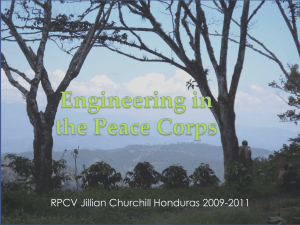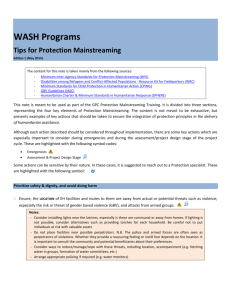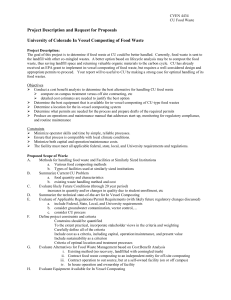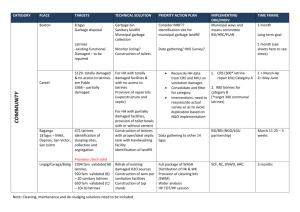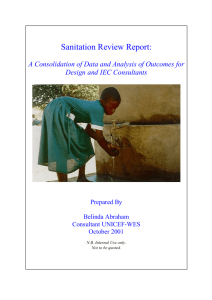(projdoc). - GlobalGiving.co.uk
advertisement
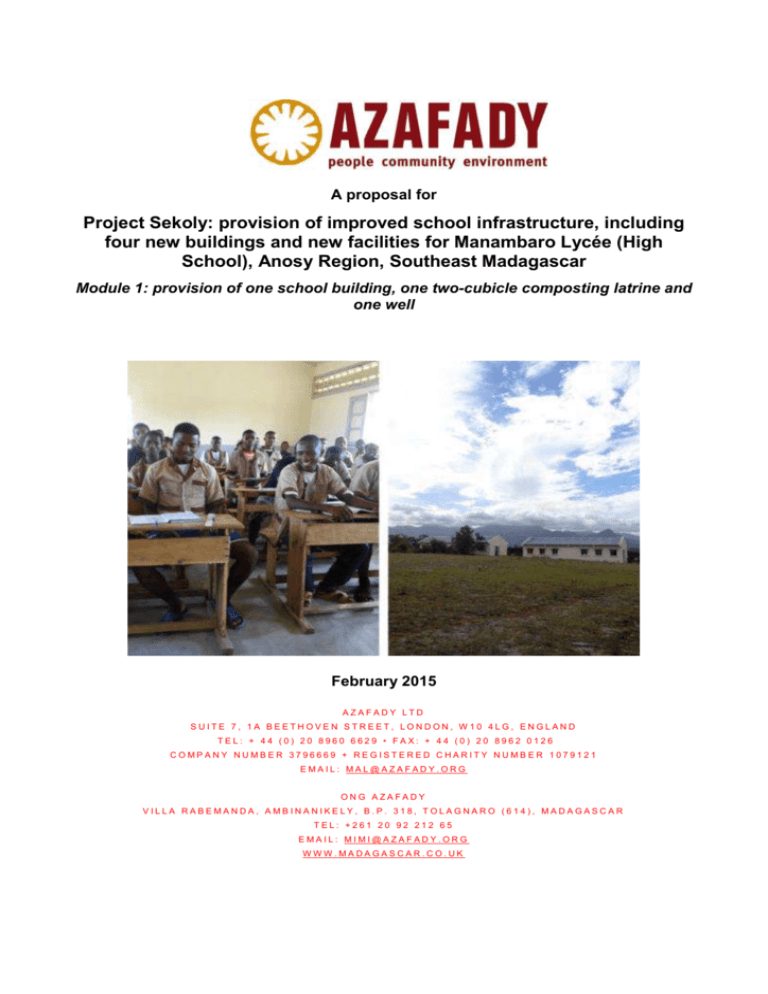
A proposal for Project Sekoly: provision of improved school infrastructure, including four new buildings and new facilities for Manambaro Lycée (High School), Anosy Region, Southeast Madagascar Module 1: provision of one school building, one two-cubicle composting latrine and one well February 2015 AZAFADY LTD SUITE 7, 1A BEETHOVEN STREET, LONDON, W10 4LG, ENGLAND TEL: + 44 (0) 20 8960 6629 • FAX: + 44 (0) 20 8962 0126 COMPANY NUMBER 3796669 + REGISTERED CHARITY NUMBER 1079121 EMAIL: MAL@AZAFADY.ORG ONG AZAFADY VILLA RABEMANDA, AMBINANIKELY, B.P. 318, TOLAGNARO (614), MADAGASCAR TEL: +261 20 92 212 65 EMAIL: MIMI@AZAFADY.ORG WWW.MADAGASCAR.CO.UK ‘Ny fianarana no lova soa indrindra’ ‘Education is the best heritage’ - Anosy proverb 1: Project Summary Project Title: Provision of improved school infrastructure, including four new buildings and new facilities for Manambaro Lycée (High School), Anosy, Southeast Madagascar; Module 1: provision of one school building, one two-cubicle composting latrine and one well Project Aim: To increase access to formal education and adequate sanitation facilities for young people aged 15 - 24 years in order to enhance their quality of life, build community capacity and alleviate poverty in the Anosy Region Location: Manambaro, Manambaro Rural Commune, Anosy, Southeast Madagascar Module 1 Duration: Five months Executive Summary There is a pressing need for resources at all levels of the Malagasy education system. In the rural Anosy Region, lack of capacity is particularly severe, with rates of illiteracy reaching 73%. The low regional pass rate of the national school leavers examination is a significant barrier to development in Anosy, resulting in employment opportunities across key sectors going to better-educated workers from elsewhere in the country, and in few people from the region attaining sufficient schooling to become fully qualified teachers, perpetuating the cycle of poverty. There are only three public high schools in the south of the region and the recently opened Manambaro Lycée is forced to turn away up to 500 students each year due to a lack of classrooms. The current site does not have a water point or latrines; students at the school defecate in bushes and drink from a pond. Through the four modules of this initiative Azafady aims to address the high level of demand for school infrastructure by providing four durable school buildings constructed from concrete, brick and rock, each containing two fully furnished classrooms. Azafady will also dig a well to supply clean water and build four two-cubicle composting latrines at the school; the latrines can provide fertiliser to support subsistence agriculture in the area. These activities will be supported by sanitation education and the establishment of committees drawn from members of the community and responsible for the management and maintenance of the facilities. This first project module addresses the need for one school building, one two-cubicle latrine and the well. This initiative has been identified as being of the highest priority by the local education authority (CISCO), and Azafady has received ongoing requests for assistance from CISCO, the Mayor of the Commune and the school’s Head Teacher. Azafady is extremely well placed to deliver this project, having supported 18 communities in the region with similar school building interventions since 2006. It is anticipated that over 2,500 children and young people will access the school over the next decade; Manambaro Lycée’s increased capacity will thereby foster direct social and economic benefits for an estimated 12,500 members of households, with diverse impacts of a better educated population felt throughout south Anosy’s population of 400,000. 1 2: Organisational Background Azafady is a partnership between Azafady UK, a British charity (1079121), and ONG Azafady, an independent Malagasy NGO responsible for the implementation and monitoring of all Azafady projects on the ground in Madagascar. The two organisations work together according to their Memorandum of Understanding in a collaboration that has capacity building and skills sharing at its core. Azafady has over 15 years of project experience in southeast Madagascar and during this time has developed strong working relationships with the local population, maximising their participation in all stages of project development and implementation. Azafady is a recognised regional specialist at capacity building at the community level (empowerment, information, education and training, advocacy), including expertise in impact evaluation processes. It is estimated that over 125,000 people have benefited from the projects implemented by Azafady in the last decade. Azafady’s mission is to work with communities to tackle the immediate effects of poverty, support long-term development and protect the environment. Azafady aims to build the capacity of individuals and organisations to lead and support sustainable conservation and development initiatives in southeast Madagascar, with the objectives of securing local community access to quality health, education and livelihoods assets, and increasing local capacity to conserve and manage natural resources including unique but greatly endangered forest environments. At the heart of Azafady’s work is an integrated approach to community development, sensitively built around the directly expressed needs of local populations. Azafady is extremely well placed to deliver this project, having supported 18 communities in southeast Madagascar with similar school building and educational interventions since 2006, including long-term follow up to ensure that the school buildings and sanitation facilities continue to be used. Azafady currently employs 60 Malagasy staff, 10 long-term international volunteers and specialists and two full time international staff in Madagascar, as well as three members of staff in London who are supported by a team of dedicated volunteers. 2 3: Project Rationale 3.1 Background Madagascar is one of the most impoverished and least developed countries in the world, ranking 151/187 on the UNDP 2013 Human Development Index. Within the remote Anosy region in the southeast of the country, the effects of chronic poverty are seen at their most extreme. More than four fifths of the local population earn less than the global poverty line of $1.25/day (UNDP, 2013), half of school-aged children have never been to school and, of those that do attend, more than a third do not complete primary education (UNESCO, 2012). Additionally, 45% of children and young people are involved in income-generating activities (INSTAT, 2010), which keep them from attending formal education. As a result, while the literacy rate in Madagascar In rural Anosy, as a whole is 64% (UNESCO, 2009), in the Anosy region the literacy rate is a mere 35%, falling as low as 27% in rural areas 73% of the (INSTAT, 2010). While the government has adopted a strategy population is paper for poverty reduction, the isolation of the region and lack of government capacity means that service delivery is extremely illiterate limited, with no upkeep or provision of education infrastructure. Prior to 2009, Madagascar was making slow but definite progress towards the Millennium Development Goal of achieving universal primary education. However, political instability since the coup in 2009 has led to an 82% fall in national investment in education (World Bank, 2011), significantly impacting on the quality of education available to the island’s children and young people, who constitute some 43% of the population (UN DESA, 2010). It is hoped that increased political stability following recent elections will eventually halt or reverse this decline, but for the moment schools in the Anosy region are unsustainably over-capacity. With population growth of 3% per year (World Bank, 2013), demand for infrastructure is immediate and urgent. Along with deficient school infrastructure, students are faced with severely inadequate access to sanitation facilities. Nationally, only one quarter of schools have a source of drinking water and latrines are in short supply, with an average of one latrine for 1,900 students (MEN, 2012). As a result, diarrhoea causes the loss of some three million school days every year in Madagascar (World Bank, 2011). 3 The effects of inadequate educational provision are particularly evident in the Anosy region. Without passing the Baccalaureate examination at the end of Lycée (high school), access to formal employment and further educational opportunities is severely limited. However, under the current national education system, those who do not pass their end-of-year exams twice in a A population pyramid produced by INSTAT, illustrating the high proportion row are dismissed from public (i.e. of young people in Madagascar’s population. non fee-paying) schools. As a result, the acute lack of capacity in Anosy leads to high drop-out rates throughout primary, middle and high schools, with only 100 - 200 students passing the Baccalaureate each year through public high schools – in a region with a population of approximately 400,000, of which 170,000 are school aged children (CISCO, 2014 and INSTAT, 2010). At present, due to a lack of qualified local candidates, the majority of employment in the key tourism and mining sectors go to well-educated immigrants from the highlands in the middle and north of the country. With few ties to Anosy, these workers tend not to settle and so, despite a pool of high-quality employment opportunities, little economic benefit accrues to the region. Additionally, Fewer than 200 students lack of adequate capacity results in under- or unqualified teaching staff, creating a self-sustaining pass their Baccalaureate cycle that further hampers development. exam each year through non-fee paying schools There is therefore a vital need for improvements to in Anosy educational infrastructure in Anosy’s under-resourced and insanitary public high schools in order to ensure access to education for all, while maintaining a safe and healthy learning environment, retaining students throughout their education and increasing the number of individuals passing the Baccalaureate at the end of high school. Better infrastructure will enable students to achieve their potential and, in doing so, will support the local human resource base and promote sustainable regional development in the long term. 3.2 Project History Since 2006, Azafady has been implementing primary school building projects in the Anosy region through Project Sekoly (meaning ‘school’ in Malagasy). Primary schools have been constructed in response to requests for assistance received from Circonscription Scolaire (CISCO, the district education authority), or direct requests from rural villages, where access to basic education facilities has historically been extremely limited. For each of these projects Azafady entered into formal agreement with the 4 community, providing materials, technical expertise and labour for the construction of a wooden primary school building containing two fully furnished classrooms, with villagers contributing locally available materials including rocks, sand and water. Each project has involved Azafady’s construction team working alongside local community members besides international volunteers recruited through the award-winning ‘Pioneer’ programme, maximising cost effectiveness while providing valuable opportunities for cross-cultural exchange. To date Azafady has completed 15 wooden primary school buildings, with water and sanitation facilities installed on site as necessary. These projects have been implemented in collaboration with CISCO, the body responsible for recruiting qualified teachers for all schools provided by Azafady in order to ensure their sustained use. Madagascar is considered to be one of three countries most vulnerable to the effects of climate change (Maplecroft, 2010) and worsening climatic conditions in the region, with increasingly frequent and powerful cyclones, have weathered these wooden schools more rapidly than anticipated. Since 2010, Azafady has repaired 11 of the 15 wooden primary schools and installed weather-proofing measures such as verandas to extend their lifespan. Meanwhile, stocks of sustainably sourced timber have decreased and prices have risen. Two composite images showing stages in the construction of a middle school complex with four concrete and brick buildings, built by Azafady staff and volunteers. Due to both of these factors, the six new school buildings that Azafady has constructed since 2010 have used concrete, rock and brick as alternative building materials. The design for these buildings was produced by Azafady’s Head of Construction in collaboration with a local masonry specialist and Azafady’s Head of Quality Control. As sand, water, gravel, rock and clay bricks are all available locally, the building materials are sustainable and inexpensive and it is anticipated that these school buildings will require minimal maintenance and repair due to the greater durability of the materials used. The six buildings most recently constructed by Azafady have all been for CEGs (middle schools), aimed at supporting the provision of middle school education in the region and increasing the number of students that progress to high school and beyond. The proposed activities at Manambaro Lycée will be the first Azafady building project to involve a high school. 3.3 Project Context Manambaro is the largest village within Manambaro Rural Commune, an administrative district in the Anosy region. As the commune centre, the village is an important regional hub and, in addition to its primary school, it has a middle school and a high school: Manambaro Lycée. 5 While Manambaro’s primary and middle schools are well established, the Lycée was built in early 2011 by Direction Regional de l’Enseignement National (DREN, the regional educational authority) to address a severe lack of high school capacity in south Anosy. Prior to the school’s opening in October 2012, there were only two high schools in the region. Located in the urban centre of Fort Dauphin and in the remote town of Amboasary – both many hours’ walk from Manambaro – in theory these two schools served 25 local middle schools. However, in practice the schools are too far from the majority of middle schools and are not large enough to cope with the number of young people who wish to attend. Furthermore, as a key location for cattle rustling, the security situation in Amboasary has been deteriorating for several years and parents are reluctant to send their children there. In 2013, DREN announced three further high schools in communities situated to the north of Fort Dauphin, although to date only one of these three schools has any classrooms. 6 A view of Manambaro Lycée’s two buildings, with part of Manambaro Rural Commune in the background. The school’s open defecation site is to the left of the image. DREN’s efforts to increase the number of high schools in rural Anosy are much needed and, once fully established, these schools will increase access to post-middle school education for large numbers of young people. Not only are they closer to most rural middle schools than the high schools in Fort Dauphin and Amboasary, they are also more affordable. Living costs are lower outside of the regional capital of Fort Dauphin and there is a greater likelihood that a prospective student will have an extended family member in one of the communities who can provide accommodation Despite the establishment of new schools, capacity issues in the Next year, the region remain critical. Manambaro Lycée in particular serves a large newest grade and populous catchment area containing 16 middle schools. The school can support an intake of 100 students per year and has will lack any turned away between 400 and 500 prospective students in each of classrooms the two years that it has been open. The two buildings constructed by DREN are of high quality, but each supports only 100 students. With 200 students already attending and three mandatory high school grades, during the next academic year (starting in October 2014) one grade will completely lack a building. As an interim solution, the Head Teacher has reached an agreement with the mayor that the newest intake will be taught in the town hall. This is not a permanent arrangement - nor an appropriate location, as the town hall is situated far from the school site and next to a busy regional market. Second-year students in a class at Manambaro Lycée As a further effect of DREN’s lack of capacity, the buildings were provided completely unfurnished. In 2013, through Project Fanaka (meaning ‘bench’ in Malagasy) Azafady was able to provide enough benches for one building, but the remaining benches had to be constructed by other local 7 Students have to defecate in nearby bushes and drink from a pond operators and were not built to a high standard. Lack of appropriate furniture also means that textbooks must be kept in the Head Teacher’s house in the village for security reasons, and that science demonstrations cannot take place. Furthermore, the school completely lacks toilet facilities, or any source of clean water for drinking and hand washing. The 200 students attending the school drink from a pond and defecate in the open, in nearby undergrowth, with serious implications for their health and, consequently, their continued education. 3.4 Proposed Activities Through the four modules of this Project Sekoly initiative, Azafady proposes to build four new brick and concrete school buildings each containing two classrooms on site at Manambaro Lycée, four twocubicle composting latrines and one well. The first module of the initiative will contribute the first of the school buildings, one of the latrines and the well. The school building will contain 40 standard twoseater benches, one lockable stationery cupboard, one bookshelf and one long table with matching benches for science demonstrations. The project Students defecate in the undergrowth next to their has been designed so that at completion of the four school modules, the total amount of new furniture will be sufficient to ensure that every classroom in the school has enough furniture for students to be seated appropriately, including in both of the existing buildings. Azafady anticipates that the provision of the four new school buildings will give access to a full day of school in appropriate facilities for 600 students across three grades, solving the school’s current capacity issues and enabling twice as many students to be admitted each year in the future. This will directly benefit the 2,500 high school students who access the school over the next decade, with impacts for some 12,500 members of their households, who will benefit from their enhanced education and employability (estimate based on average household size in Anosy, INSTAT, 2010). The increased numbers of individuals completing high school is in turn expected to help drive development across the south of Anosy. The pool from which students drink. Additionally, Azafady will build a well at the school along with four two-cubicle composting latrines. A Community Health Agent and a Health Education Manager from Azafady’s Water, Sanitation and Hygiene (WASH) team will engage in activities to encourage the appropriate use and maintenance of the well and latrines. These activities will reinforce improved sanitation practices at the school and in the surrounding community. Activities will include: WASH education for students, including hand washing and 8 water purification demonstrations; support to the community and the local parent-teacher association in establishing committees to manage and maintain the well and the latrines, and delivery of training to these committees in skills including maintenance, safe use practices and financial management, to ensure the appropriate and sustainable use of the new facilities. 4: Project Approach 4.1 Cost Summary Azafady will construct each school building on a foundation of reinforced concrete and rock. The walls will be constructed of reinforced concrete columns with courses of bricks laid between, with the interior and exterior surfaces covered in a concrete finish. The roof will be constructed of corrugated metal sheeting on an overbuilt wooden frame and cyclone-proofed with reinforced concrete fastenings at the sides. Overall, the design ensures soundness of structure and excellent value for money. The building will be strong and easy to maintain, and will be constructed using locally available materials, keeping costs to a minimum. The same design has been used successfully by Azafady in six previous school buildings. Excerpt from plans produced by the Azafady construction team. All classroom furniture will be built of locally sourced sustainable timber and built to a durable design, including reinforcements to maintain the furniture’s stability. Through Projects Sekoly and Fanaka, Azafady has built benches to a similar design since 2006 – all of which are still in daily use in schools throughout south Anosy. The well will be dug by hand to a depth of four or more metres – the pit is dug during the peak of the dry season when the water table is at its lowest and digging continues until water is found. Concrete rings are then placed in the pit to line it, with layers of gravel and sand at the bottom to filter the water entering the well. PVC riser pipes connect the water with the pump at ground level and the well is capped with a concrete lid and a Canzee pump. Finally, a concrete surround ensures that runoff travels several metres from the well before returning to the ground, helping to ensure the water entering the well remains clean. Since 2001, this and similar designs have been used many times by Azafady’s WASH team. The design was originally chosen because its simplicity and easily replaceable components enable communities to manage and repair Previous beneficiaries of an Azafady project the wells themselves as necessary. carry benches to their school Each latrine will be built of concrete-skinned breezeblocks on top of an elevated concrete platform, above a breezeblock composting chamber. In line with international best practice, each latrine will have two cubicles, one for female students and one for male students. The composting chamber beneath will contain a partition to allow the use of one half while 9 composting takes place in the other half. The design is such that it is straightforward to switch between the two halves of the chamber and to empty the chamber of fertiliser following composting. Azafady is able to reduce costs involved in the work since much of the labour required will be provided by international volunteers participating in Azafady’s award-winning Pioneer programme, along with contributions in kind from the local community. 4.2 Project Timeline Completion of all four modules of the project, resulting in four school buildings with furniture, four composting latrines and a well, is expected to take 18 months. Preparation: Meeting with CISCO and the Mayor of Manambaro Meeting with the Head Teacher Establish project timeframe, define stakeholder roles and responsibilities Source building materials Undertake baseline studies of attendance and academic performance Implementation: Transport materials to project site Construction of temporary structures for use by construction team Construction of well Groundbreaking ceremony Construction of four new brick school buildings, each containing two classrooms Construction of classroom furniture Construction of four new composting latrines Latrine management training and WASH education delivered by an Azafady Community Health Agent and a Health Education Manager Training for teachers and parent-teacher association on well management and maintenance Training for teachers and parent-teacher association on latrine management and Mme. Christalline, Head Teacher of Manambaro Lycée, in her office. maintenance Ongoing monitoring and evaluation of project progress, including regular meetings with construction team, teachers and other stakeholders, along with case studies of beneficiaries Delivery of interim narrative reports to donors Follow-up: Official inauguration Monitoring and evaluation activities, including data gathering on attendance and academic performance, and project closure debriefs Delivery of final reports to donors and local stakeholders 10 WASH follow-up activities to support the community to adopt long-term sustainable sanitation practices 4.3 Project schedule (Ideal programme, funds permitting) Month Activity 1 2 3 4 5 6 7 8 9 10 11 12 13 14 15 16 17 Temporary structures Well School Building Furniture Construction Latrine Building Finishing and murals Sanitation Management Report Delivery 18 (+) 4.4 Project Stakeholders Azafady: Azafady’s construction team will implement the project, with all technical construction details overseen by the Head of Construction and the Construction Manager. Azafady’s international Pioneer volunteers will be trained and supervised to assist with construction activities. Monitoring and evaluation will be carried out by the Head of Construction in collaboration with the project development team. Community participation: This project has been developed in response to requests for assistance from the local community. Their participation is essential in all stages of the project. Community members will contribute in kind to the construction as follows: Textbooks stacked in the corner of Mme. Christalline’s Men will contribute to the construction home. They are kept here when not in use, as the school has no secure storage. activities through the provision of locally available materials (rock and gravel) and labour Women will contribute to the construction activities through the provision of locally available materials (sand and water) Students and the parent-teacher association will receive support to become responsible for the cleaning and maintenance of the infrastructure. The well and latrine management committees, composed of teachers and parents, will be responsible for the full maintenance of the well and the latrines, including arranging for the latrines to be emptied, the compost distributed and any necessary repairs to the facilities. 11 Officials: CISCO, DREN, the Mayor of Manambaro and Manambaro Lycée’s Head Teacher have all been involved in the development of this project. They will participate in the official groundbreaking and inauguration ceremonies in accordance with traditional Malagasy culture and will continue to assist with monitoring and evaluation activities and long term follow-up. 4.5 Monitoring and Evaluation Azafady will monitor progress towards objectives throughout the duration of the project. The project development team will conduct monthly site visits to monitor construction activities and communicate with the project beneficiaries (including the head teacher, teachers, students and parents). All qualitative information from these visits Over 12,500 will be fed back into project implementation. Additional support individuals will visits will be made as the latrines become full to support the school in emptying them and distributing the fertiliser produced, benefit during enabling their continued use. Monthly meetings will be held with the next decade Azafady’s Project Development team, Head of Construction and Health Education Manager in order to assess project progress, address any challenges, and ensure the project continues to meet the practical needs of the participants as effectively and efficiently as possible. As well as case studies of individual beneficiaries, an initial baseline and end-of-project evaluation will be held to assess overall impact and feed into future project development and expansion, using quantitative data on attendance and examination pass rates. While pass rates are unlikely to change over the duration of the project, Azafady anticipates a long term increase in Baccalaureate passes, both in absolute terms and as a proportion of the number of students at the school. As with all Azafady projects, detailed financial monitoring will be in place and narrative reports will be produced for funders at six monthly intervals throughout the project. 4.6 Sustainability The project will run for eighteen months, yet positive impacts of the project’s activities will continue well beyond the project timeframe. 2,500 young people are expected to access the school over the next decade and better education is anticipated to have a variety of positive social and economic outcomes for these individuals, their households and their communities, including increased awareness of safe The Malagasy flag flies in front of the school, with Manambaro Rural Commune in the background. 12 health and sanitation practices, and the importance of conservation of natural resources. Education-related outcomes are expected to include greater appreciation of the benefits of education, with alumni encouraging school attendance within their communities, and an increase in the number of high school graduates entering the teaching profession and returning to their rural communities to teach. Overall, increased human and social capital from a better-educated population will catalyse further development in the south Anosy region, including improved provision of non-fee paying education. All infrastructure proposed as part of Project Sekoly has been designed to last and to require the minimum and simplest possible forms of maintenance. Designs have been in use by Azafady for several years and follow-up visits to previous beneficiaries of Projects Sekoly and Fanaka have confirmed that the infrastructure will last for long periods of constant use with very low levels of maintenance. Ensuring the sustainable use of the new sanitation facilities is particularly important. Students are not necessarily accustomed to the use of latrines and the maintenance of both the well and latrines is likely to be unfamiliar to the community. The latrines will be opened at the same time as The well can be each new school building. As well as ongoing support from maintained using Azafady’s staff throughout the project, including training sessions on latrine use and hand washing with students and plastic drainpipes teachers, Azafady staff will return when the latrines are full, to and car inner tubes support the school in exchanging chambers. Each cubicle will contain two sealable holes, corresponding to the two halves of the composting chamber. Once a chamber is full (a process anticipated to take approximately one year), the hole into the second chamber is unsealed in both cubicles and the previous holes are sealed while composting takes place. In addition, Azafady staff will return following composting to support the latrine maintenance committee in emptying the chambers and distributing the composted fertiliser, for use in agriculture. Composting not only provides a useful byproduct from the latrines in the form of fertiliser, but also ensures that the contents of the chambers are harmless when they come to be emptied. The community will be highly involved in the construction of the well, particularly members of the well management committee. In this way, committee members will learn and see for themselves the internal operation of the well, helping them to disassemble and maintain it when necessary. The Canzee pump design is in use throughout Madagascar and was chosen by Azafady due to its ease of maintenance. The pump is self-lubricating and is made from two lengths of uPVC tubing (available in Fort Dauphin). The no-return valves are made from rubber and can be replaced by cutting disks from old car or bicycle inner tubes (which again are readily available in the area). Management planning and financial training provided to the committees ensures that money from user subscriptions and from the sale of fertiliser is saved and can be used to pay for parts at a later date. Azafady has a permanent office in Fort Dauphin and frequent visits to Manambaro by the NGO’s experienced Community Agents will address any issues encountered after the close of the project and will help to guarantee the sustainability of Project Sekoly. 13 A student walks home at the end of the school day 5.1 Budget Summary Detail Project Sekoly Budget Exchange Rate Used = 3500 Ariary / £ 1 Cost / Unit Quantity Total Cost (Ariary) Total Cost (£) Percentage Temporary shelter 1,203,000 1 1,203,000 £344 1% Temporary latrines 234,900 1 234,900 £67 0% Materials per building 25,201,000 1 25,201,000 £7,200 26% Furniture per building 2,662,000 1 2,662,000 £761 3% Well 1,791,500 1 1,791,500 £512 2% Composting latrines 5,561,000 1 5,561,000 £1,589 6% Tools 3,404,500 1 3,404,500 £973 4% Community participation 1,597,000 1 1,597,000 £456 2% Communications 1,395,000 1 1,395,000 £399 1% Transport Accommodation and subsistence 4,702,000 1 4,702,000 £1,343 5% 11,148,500 1 11,148,500 £3,185 12% Human resources 23,611,900 1 23,611,900 £6,746 25% Madagascar costs 6,300,000 1 6,300,000 £1,800 7% UK costs MEL (Monitoring, Evaluation & Learning) 2,625,000 1 2,625,000 £750 3% 4,140,000 1 4,140,000 £1,183 4% 95,577,300 £27,308 100.00% GRAND TOTAL 14


